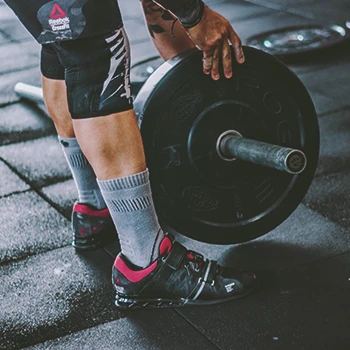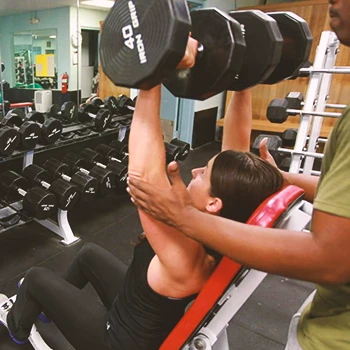As a certified fitness trainer, I like using the 5x5 training program with my clients, both beginners and advanced, due to its simplicity, efficiency, and emphasis on the major compound workouts.
It has proven to be a no-frills muscle-building and strength-training workout that works.
In this article, I will detail my findings and expertise on the best 5x5 workout, how to design your 5x5 training regimen, and the benefits and tips for planning your 5x5 routine.
Quick Summary
The Original 5x5 Program

The 5x5 workout is a basic and efficient training routine for increasing strength, muscle, and athleticism.
The original 5x5 divides your workout into three days: an intense day on Monday, a light day on Wednesday, and a medium day on Friday.
You'll concentrate on the squat, different presses, and the bar row (or power clean), with only a few more workouts outside the core lifts.
Because each exercise will be based on your one-rep max (1RM) percentage, knowing your max for each major lift is essential.
The program instructs you to do a top set at a certain percentage of your 1RM for each exercise, utilizing the previous four sets to ramp up gradually.
Bill Starr's 5x5 may be advanced by raising the load of your predicted 1RM by 2.5% weekly.
If (or when) you miss a repeat on a single lift or discover that the program has gotten too difficult, deload by reducing the weight by 10% and continue.
Monday (Heavy Day):
- Barbell Row or Power Clean: 5 sets of 5 repetitions, top set at 85% of 1RM
- Bench Press: 5 sets of 10 repetitions, top set at 70% of 1RM
- Squat: 5 sets of 10 repetitions, top set at 85% of 1RM
Wednesday (Light Day):
- Barbell Row or Power Clean: 5 sets of 5 repetitions at 65% of your 1RM
- Incline Bench Press: 5 sets of 10 repetitions at 65% of your 1RM
- Squat: 5 sets of 5 repetitions at 65% of your 1RM
Friday (Medium Day):
- Barbell Row or Power Clean: 5 sets of 5 repetitions at 70% of your 1RM
- Incline Bench Press: 5 sets of 10 repetitions at 70% of your 1RM
- Squat: 5 sets of 5 repetitions at 70% of your 1RM
Every exercise in a 5x5 routine is a compound barbell workout. These are the barbell back squats, bench press, row, overhead press, and deadlift.
This routine emphasizes low repetitions with heavy weights, and I typically advise increasing the weight after every 2-week cycle.
However, it's crucial not to jump to the heaviest weights right away, as completing the sets can become quite challenging.
"Choose a load that allows you to complete seven or eight repetitions. This is almost 80% of your maximum. So, let's assume you're reasonably sure you can squat 220 pounds for a single rep, and you want to perform a 5x5 exercise. Eighty percent of 220 equals 176 pounds, so load 176 for your first set."
- C. J. Murphy, Competitive Powerlifter & Strongman
Designing Your 5x5 Training Regimen

I recommend the 5x5 set or rep system for steady and consistent strength gains.
By following the core principles of this program, you can tailor your own 5x5 workout to see progress over several months.
If Bill Starr's original routine doesn't suit you, feel free to adapt the basic formula to fit your program.
Here's how:
- You'll train your entire body three times weekly, alternating between three compound motions per session, but not more than three exercises.
- Instead of a heavy, light, and medium day, you'll follow a more simple pattern. For every five sets of five repetitions, use 70–80% of your 1RM.
- Aim to add a small amount of weight (2.5 to 10 pounds) weekly. If you can't lift more, remain with the same load and try to add weight to only one or two sets.
- Isolation exercises are not prohibited. However, if you're tired or sore, don't include them. You should only do these activities (triceps extensions, biceps curls, lateral raises, and so on) if you've got the time and strength after the core program is finished.
The 5x5 Workout Program

The 5x5 requires 80% of your one rep max (1RM) in week one, then 2.5% in week two, and so on.
This approach can be followed for 8–12 weeks, but you will ultimately reach a point where you cannot achieve the 2.5% increase.
Here's the game plan: stick with the same weight for a week or two, then bump it up the next week.
This routine's got bodyweight training too, but forget the 5x5 reps on those days. You'll be using the Rate of Perceived Exertion (RPE) to track your effort, following these rules.
- Sets 1–4 will consist of as many repetitions as possible (AMRAP) exercises until you reach an RPE of 8 (two reps in reverse). Then, on the fifth set, you will do maximum reps.
- While you will do 5 sets of each activity, they will not be performed consecutively. Instead, you will alternate workouts.
- Remember that this is not a circuit exercise. That is, you are not moving from one workout to the next. You will still relax in between sets. This allows you to increase your volume for muscular growth.
- Chin-ups should be done between 4 and 12 reps, while dips should be done between 6 and 15.
Related: How the 5x5 Workout Can Benefit Over 50s
The Best 5x5 Workout Plan

Monday:
- Barbell Back Squat: 4 sets of 5 repetitions with 1 set AMRAP
- Barbell Bench Press: 4 sets of 5 repetitions with 1 set AMRAP
- Barbell Bent Over Row: 4 sets of 5 repetitions, with 1 set AMRAP
Wednesday:
- Barbell Back Squats: 3 sets of 10 repetitions
- Chin Ups: 4 sets of RPE8 and 1 set max
- Lunges: 4 sets of RPE8 and 1 set max
- Dips: 4 sets of RPE8 and 1 set max
Friday:
- Barbell Deadlift: 4 sets of 5 repetitions with 1 set AMRAP
- Barbell Shoulder Press: 4 sets of 5 repetitions with 1 set AMRAP
- Barbell Bent Over Row: 4 sets of 5 repetitions with 1 set AMRAP
Progression With 5x5 Workout

I find the 5x5 workout straightforward and effective: you follow the same routine each session, increasing the weight only after you successfully complete five reps in all five sets.
For instance, if you're bench pressing 140 pounds and your reps are 5, 5, 5, 5, and 4, keep at that weight until you consistently hit five reps across all sets.
Adding 2.5kg (5 lbs) to the bar is an excellent idea. For instance, if you get five repetitions throughout five sets with 140 pounds on the bench press, train with 145 the next time.
I often see people advocating adding 5kg (10 lbs) to the deadlift, but always be wise about the weight increase. If you're comfortably lifting 310 pounds for 5x5, try pushing to 320 pounds next week, or just bump it up to 315 if that feels too challenging.
For exercises like rows and presses, opt for smaller increments, around 1kg (2 lbs), to maintain good form.
Remember, gradual progress is crucial. Research from the National Institute of Health (NIH) indicates that both linear and daily undulating periodization (DUP) are effective for muscle growth [1].
I recommend sticking with linear programming, as according to the NIH, it is great for steady strength and muscle development [2].
Posts You May Like:
Tips for an Effective 5x5 Workout Routine

Warming Up
In addition to the required warm-up regimen, we recommend performing some basic warm-up rounds for each activity.
Start with an empty bar and gradually raise the weight until you reach your maximum lifting weight.
According to the NIH, correctly warming up will increase your longevity and enable you to work out more effectively in the long run [3].
Rest Between Sets
The main objective of resting between sets is to give your muscles a little break to regain enough strength to complete the workout's repetitions.
This can vary depending on the person, but standard suggestions recommend resting between sets using heavier weights for 2 to 5 minutes.
When in doubt, rest a little more than usual. As noted by the NIH, this leads to faster muscle growth and helps you do better on each set [4].
Manage Your Volume

The 5x5 program has a fixed number of exercises per session, designed to focus on strength. Recovery is the key to success.
Overloading with extra exercises can lead to burnout from the intense barbell routines. It's crucial to keep workout volume in check.
The 5x5 plan does this by limiting extra workouts beyond the core 5 sets of 5 reps, often adding just 0 to 2 additional lifts per session after the day's main compound exercises.
Pick Appropriate Weights for Your 5x5 Workout
You should ease into the 5x5 workout regimen since you're just starting.
Easing into this might vary in time and magnitude depending on how you've been training so far.
In general, we advise beginning modestly and developing from there.
For instance, if you know your 1RM on the core lifts, start at roughly 50% of your 1RM.
If your best overhead press is 220 pounds, begin training sets with about 110 pounds.
This accomplishes two goals:
- For starters, it helps you become used to routine and frequency.
- Second, it allows you to build momentum and understand your direction.
Instead of plateauing after a few weeks because you started with heavy weights, you can gradually gain more weight in a few weeks. This is excellent for morale and motivation.
Benefits of a 5x5 Training Regimen

It Provides the Best Training Frequency
According to studies, working the muscles twice a week is preferable to training them once a week for hypertrophy [5].
The 5x5 strength training program, despite its low volume, hits the sweet spot for those aiming to build muscle and strength. It involves just five exercises, but each targets multiple muscle groups effectively.
This approach stimulates all the major muscles, offering a straightforward path to growth.
Plus, since you're using a barbell for each move, the overload potential is top-notch, piling on the mechanical stress, which, according to the NIH, is crucial for muscle development [6].
It Is Perfect for Beginner and Intermediate Lifters

A 5x5 exercise regimen concentrates on the fundamentals while removing any unnecessary stuff.
Not that this extra stuff is inherently bad, but many beginners might wind up concentrating on it too much.
You will also concentrate on the basic motions you employ in your workouts for years afterward.
It Aids in the Development of Neuromuscular Efficiency
Neuromuscular efficiency means getting more muscle to work harder. It's specific to each task but boosts other activities too. Take back squats: the more you do 'em, the better your muscles get at them.
The 5x5 program rocks for this, letting you practice moves like squats three times a week. This repetition hones your ability to use the right muscles for each squat. So, you'll see your squat game improve, even without bulking up.
It Concentrates on Compound Lifts

The 5x5 program is built around multi-joint, compound exercises.
The major lifts in any version will include barbell squats, rows, deadlifts, cleans, and different presses.
These exercises require a great deal of full-body coordination and strengthen numerous muscle groups at the same time.
Because there are no machines or isolation exercises, your entire body will be pushed to grow stronger by fully controlling the barbell lifts by hand.
"Compound exercises with multi-joint motions involving more than one muscle group can be particularly helpful in achieving advantages from all three types of fitness: cardiovascular, flexibility, and strength."
- Pete McCall, ACE Certified Personal Trainer
It Increases Maximum Strength
Because of the short repetitions, you'll be lifting weights that are heavy compared to your present strength capacity and body size.
This intense exercise instructs your nervous system to engage each muscle fiber fully, allowing you to create more power with the same muscle fibers over time.
According to a study from the National Library of Medicine, this leads to significant gains in general strength, including 1RMs, and the capacity to easily move lesser weights because the same weight will eventually represent only a fraction of your 1RM [7].
It's Simple (Having a Specific Objective)

I find the 5x5 workout plan exceptional for its simplicity and clear objectives. It's straightforward to follow, allowing for easy progress tracking without confusion.
With only three exercises per session, monitoring your improvements becomes effortless and it really saves on gym time.
You'll mainly use the squat rack, which means less waiting for equipment and minimal moving around the gym.
It Boosts Metabolism
Moving heavy loads demands a lot of energy. As a result, your metabolism must be stimulated during and after the workout to heal your muscles and eliminate the waste products of working hard.
Furthermore, maintaining added muscle demands more calories.
As a result, the 5x5 program can help you burn a significant number of calories gradually, which, according to the NIH, can help you lose or maintain body fat even if you continue to consume the same number of calories [8].
Comparison with Other Strength Training Protocols
The 5x5 workout focuses on compound movements with five sets of five reps, ideal for building raw strength and muscle mass. Its structured progression is great for beginners but may lack variety for advanced lifters.
In contrast:
- High-Intensity Training (HIT) involves fewer sets with maximum effort, emphasizing muscle fatigue over volume, making it suitable for time-efficient workouts but potentially leading to quicker burnout.
- Bodybuilding routines, with higher reps and varied isolation exercises, excel in muscle sculpting and definition but may not yield the same strength gains as 5x5.
- Lastly, CrossFit combines strength with cardiovascular elements, offering holistic fitness but requiring higher skill and intensity levels, which might not suit everyone.
FAQs
Is 5x5 the Best for Building Muscle?
Yes, 5x5 is the best for building muscle. However, note that while trying to develop lean muscle mass or bulk, you should be in a calorie surplus to aid in protein synthesis.
Are 5x5 Workouts Effective?
Yes, 5x5 workouts are effective. The 5x5 concentrates on the primary movements for a full-body workout that will increase athletic performance, strength, and muscle mass.
How Long Should You Perform a 5x5 Program?
You should perform a 5x5 program for at least 4 weeks. If you complete all of your repetitions, you should set new rep maximums and see considerable gains in strength and muscle. If you're still making progress, keep going for another four weeks.
Can You Get the Benefits of 5x5 Workout Over 50?
Yes, you can definitely get the benefits of a 5x5 workout over 50. It’s a great way to get back in shape. You’ll want to prioritize safety and good form during your training routine, overperforming lifts to prevent injuries.
References:
- https://www.ncbi.nlm.nih.gov/pmc/articles/PMC5571788/
- https://www.ncbi.nlm.nih.gov/pmc/articles/PMC6416506/
- https://pubmed.ncbi.nlm.nih.gov/19996770/
- https://pubmed.ncbi.nlm.nih.gov/26605807/
- https://pubmed.ncbi.nlm.nih.gov/27102172/
- https://pubmed.ncbi.nlm.nih.gov/20847704/
- https://pubmed.ncbi.nlm.nih.gov/28834797/
- https://www.ncbi.nlm.nih.gov/pmc/articles/PMC3661116/
About The Author
You May Also Like






